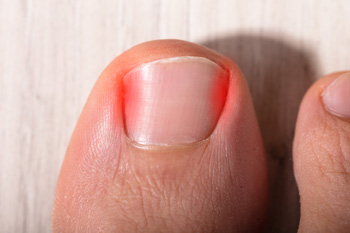
Ingrown toenails are very uncomfortable afflictions of the feet. Usually affecting the big toe, ingrown toenails occur when the side of a toenail essentially grows into the skin surrounding the nail. As a result, the skin then covers the nail partially or completely at the side of the nail. Ingrown toenails can be very painful. This pain is only exacerbated if the ingrown toenail becomes infected, which can lead to redness and swelling in the affected area. There are several steps that you can take to prevent an ingrown toenail. For example, you can make sure that you are properly cutting your nails to keep them at an appropriate length, neither too long nor too short. You also could keep them cut in an appropriate shape, straight cut at the top instead of curved. You might even be sure that the shoes that you typically wear are spacious enough in the toe box and do not press against your toes. If you have an ingrown toenail or are concerned about getting one, consult with a podiatrist.
Ingrown toenails can become painful if they are not treated properly. For more information about ingrown toenails, contact Dr. Mark Gagnon of Advanced Podiatry. Our doctor can provide the care you need to keep you pain-free and on your feet.
Ingrown Toenails
Ingrown toenails occur when a toenail grows sideways into the bed of the nail, causing pain, swelling, and possibly infection.
Causes
- Bacterial infections
- Improper nail cutting such as cutting it too short or not straight across
- Trauma to the toe, such as stubbing, which causes the nail to grow back irregularly
- Ill-fitting shoes that bunch the toes too close together
- Genetic predisposition
Prevention
Because ingrown toenails are not something found outside of shoe-wearing cultures, going barefoot as often as possible will decrease the likeliness of developing ingrown toenails. Wearing proper fitting shoes and using proper cutting techniques will also help decrease your risk of developing ingrown toenails.
Treatment
Ingrown toenails are a very treatable foot condition. In minor cases, soaking the affected area in salt or antibacterial soaps will not only help with the ingrown nail itself, but also help prevent any infections from occurring. In more severe cases, surgery is an option. In either case, speaking to your podiatrist about this condition will help you get a better understanding of specific treatment options that are right for you.
If you have any questions please feel free to contact one of our offices located in Crestwood, Orland Park, and Summit, IL . We offer the newest diagnostic and treatment technologies for all your foot and ankle needs.
